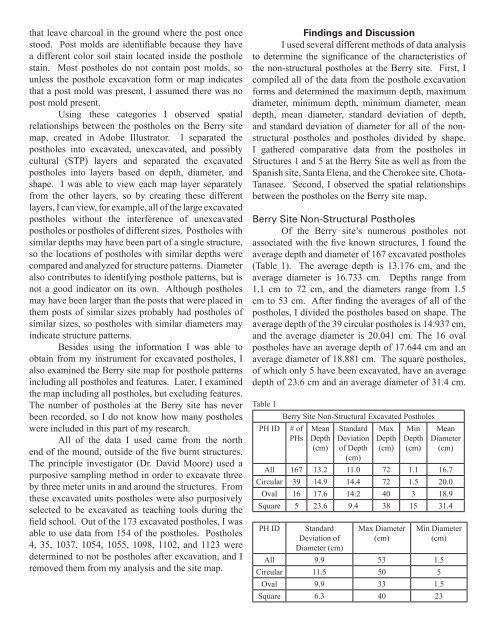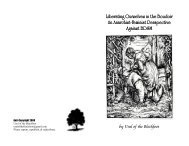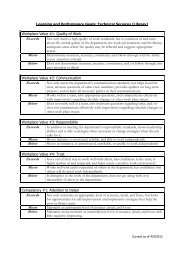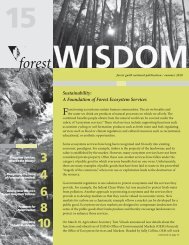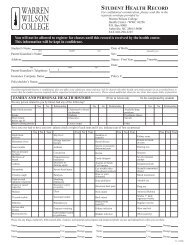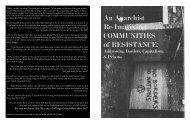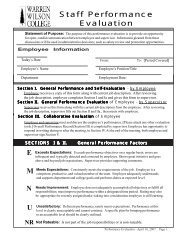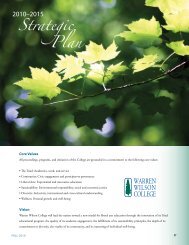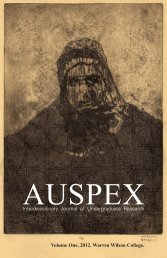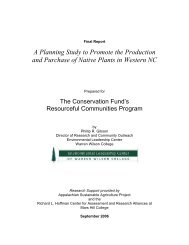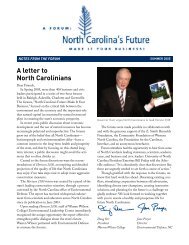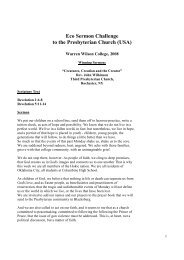Native American and Spanish Ancillary Structures - Warren Wilson ...
Native American and Spanish Ancillary Structures - Warren Wilson ...
Native American and Spanish Ancillary Structures - Warren Wilson ...
You also want an ePaper? Increase the reach of your titles
YUMPU automatically turns print PDFs into web optimized ePapers that Google loves.
that leave charcoal in the ground where the post once<br />
stood. Post molds are identifiable because they have<br />
a different color soil stain located inside the posthole<br />
stain. Most postholes do not contain post molds, so<br />
unless the posthole excavation form or map indicates<br />
that a post mold was present, I assumed there was no<br />
post mold present.<br />
Using these categories I observed spatial<br />
relationships between the postholes on the Berry site<br />
map, created in Adobe Illustrator. I separated the<br />
postholes into excavated, unexcavated, <strong>and</strong> possibly<br />
cultural (STP) layers <strong>and</strong> separated the excavated<br />
postholes into layers based on depth, diameter, <strong>and</strong><br />
shape. I was able to view each map layer separately<br />
from the other layers, so by creating these different<br />
layers, I can view, for example, all of the large excavated<br />
postholes without the interference of unexcavated<br />
postholes or postholes of different sizes. Postholes with<br />
similar depths may have been part of a single structure,<br />
so the locations of postholes with similar depths were<br />
compared <strong>and</strong> analyzed for structure patterns. Diameter<br />
also contributes to identifying posthole patterns, but is<br />
not a good indicator on its own. Although postholes<br />
may have been larger than the posts that were placed in<br />
them posts of similar sizes probably had postholes of<br />
similar sizes, so postholes with similar diameters may<br />
indicate structure patterns.<br />
Besides using the information I was able to<br />
obtain from my instrument for excavated postholes, I<br />
also examined the Berry site map for posthole patterns<br />
including all postholes <strong>and</strong> features. Later, I examined<br />
the map including all postholes, but excluding features.<br />
The number of postholes at the Berry site has never<br />
been recorded, so I do not know how many postholes<br />
were included in this part of my research.<br />
All of the data I used came from the north<br />
end of the mound, outside of the five burnt structures.<br />
The principle investigator (Dr. David Moore) used a<br />
purposive sampling method in order to excavate three<br />
by three meter units in <strong>and</strong> around the structures. From<br />
these excavated units postholes were also purposively<br />
selected to be excavated as teaching tools during the<br />
field school. Out of the 173 excavated postholes, I was<br />
able to use data from 154 of the postholes. Postholes<br />
4, 35, 1037, 1054, 1055, 1098, 1102, <strong>and</strong> 1123 were<br />
determined to not be postholes after excavation, <strong>and</strong> I<br />
removed them from my analysis <strong>and</strong> the site map.<br />
Findings <strong>and</strong> Discussion<br />
I used several different methods of data analysis<br />
to determine the significance of the characteristics of<br />
the non-structural postholes at the Berry site. First, I<br />
compiled all of the data from the posthole excavation<br />
forms <strong>and</strong> determined the maximum depth, maximum<br />
diameter, minimum depth, minimum diameter, mean<br />
depth, mean diameter, st<strong>and</strong>ard deviation of depth,<br />
<strong>and</strong> st<strong>and</strong>ard deviation of diameter for all of the nonstructural<br />
postholes <strong>and</strong> postholes divided by shape.<br />
I gathered comparative data from the postholes in<br />
<strong>Structures</strong> 1 <strong>and</strong> 5 at the Berry Site as well as from the<br />
<strong>Spanish</strong> site, Santa Elena, <strong>and</strong> the Cherokee site, Chota-<br />
Tanasee. Second, I observed the spatial relationships<br />
between the postholes on the Berry site map.<br />
Berry Site Non-Structural Postholes<br />
Of the Berry site’s numerous postholes not<br />
associated with the five known structures, I found the<br />
average depth <strong>and</strong> diameter of 167 excavated postholes<br />
(Table 1). The average depth is 13.176 cm, <strong>and</strong> the<br />
average diameter is 16.733 cm. Depths range from<br />
1.1 cm to 72 cm, <strong>and</strong> the diameters range from 1.5<br />
cm to 53 cm. After finding the averages of all of the<br />
postholes, I divided the postholes based on shape. The<br />
average depth of the 39 circular postholes is 14.937 cm,<br />
<strong>and</strong> the average diameter is 20.041 cm. The 16 oval<br />
postholes have an average depth of 17.644 cm <strong>and</strong> an<br />
average diameter of 18.881 cm. The square postholes,<br />
of which only 5 have been excavated, have an average<br />
depth of 23.6 cm <strong>and</strong> an average diameter of 31.4 cm.<br />
Table 1<br />
PH ID # of<br />
PHs<br />
Berry Site Non-Structural Excavated Postholes<br />
Mean<br />
Depth<br />
(cm)<br />
St<strong>and</strong>ard<br />
Deviation<br />
of Depth<br />
(cm)<br />
Max<br />
Depth<br />
(cm)<br />
Min<br />
Depth<br />
(cm)<br />
Mean<br />
Diameter<br />
(cm)<br />
All 167 13.2 11.0 72 1.1 16.7<br />
Circular 39 14.9 14.4 72 1.5 20.0<br />
Oval 16 17.6 14.2 40 3 18.9<br />
Square 5 23.6 9.4 38 15 31.4<br />
PH ID St<strong>and</strong>ard<br />
Deviation of<br />
Diameter (cm)<br />
Max Diameter<br />
(cm)<br />
Min Diameter<br />
(cm)<br />
All 9.9 53 1.5<br />
Circular 11.5 50 5<br />
Oval 9.9 33 1.5<br />
Square 6.3 40 23


